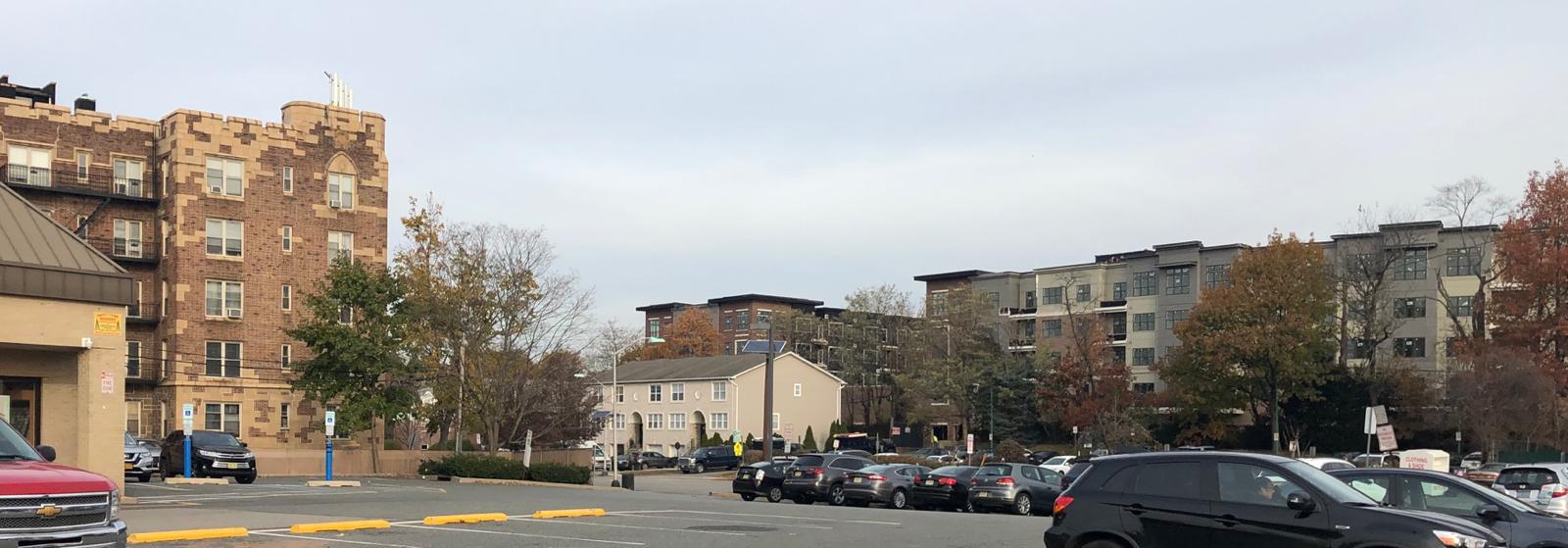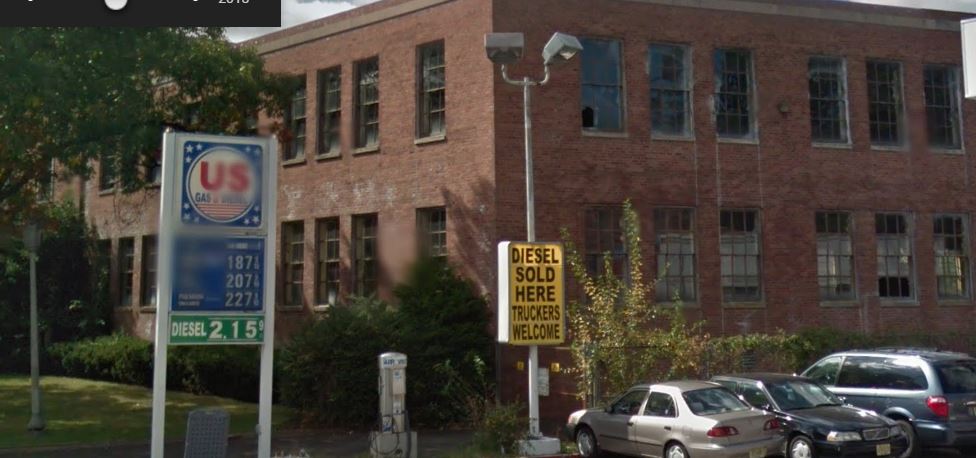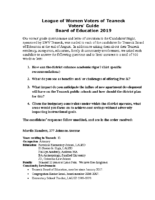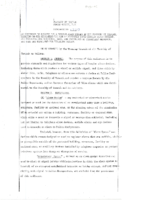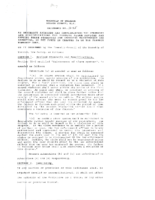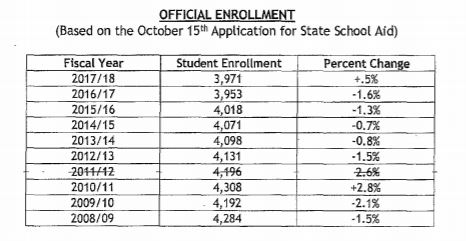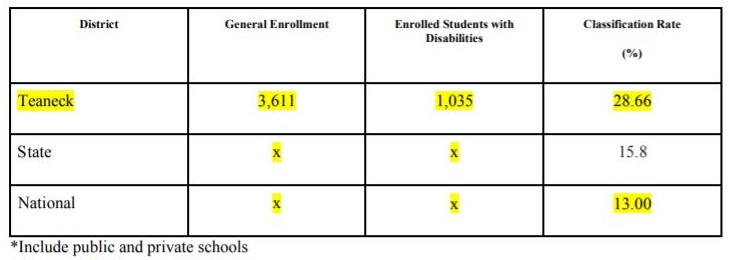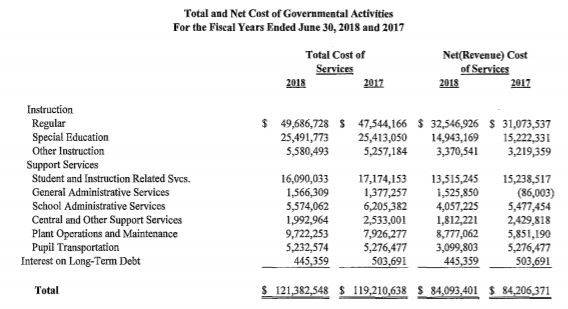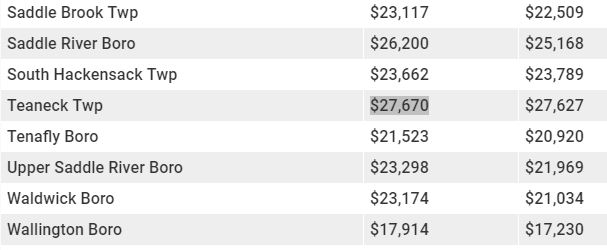Congratulations to our manager, Dean Kazinci, who was recognized today by the New Jersey Municipal Management Association with their “Outstanding Manager Award”.
Category: Teaneck
Rt. 4 upgrades coming at Decatur Ave.
In September, the Township manager sent a letter to the NJ Department of Transportation regarding the unsafe condition of the Route 4 Decatur Avenue ramps.
Manager Kazinci just received word that the NJ Department of Transportation has agreed to widen and reconstruct the ramps on Route 4 by Decatur Avenue to accommodate traffic.
Updates Schedule for Spring, 2020
The interim changes should be in place next spring. The Township will work with the NJ DOT and provide updates as the date gets closer.
Traffic Study Sceduled
A traffic study will also be performed to ensure “the site is brought into conformance with all state and national roadway standards”.
(click below for DOT letter)
A Developing Story in Teaneck
I took this picture this morning at the corner of State Street and Teaneck Road.
In the foreground on the left is the pre-war apartments by Lozier Place.
On the right in the background is 1500 Teaneck Road.
Both appear very similar in height and other than the new materials, neither looks like a stark departure from what is already found in the area.
The 1500 Teaneck Road project (see schematics here) will add approximately $1,160,000 in taxes each year, with additional money going towards municipal open space.
It will also create 23 new affordable housing units (1-bedroom (4), 2-bedroom (14) and 3-bedroom (5).
It will also contain 435 parking spaces.
(additional info can be found here)
Of note is the previous condition of 1500 Teaneck Road. Notice the numerous broken windows in the dilapidated structure that lined the neighborhood for years and years.
This is a wonderful addition to the community, will create foot traffic for our business districts and make Teaneck a more desirable place to live.
Teaneck (and NJ) Should Adopt Ranked Choice Voting
In last May’s Atlantic, Jonathan Haidt has a very powerful article in which he talks about ways to “harden democratic institutions“.
I encourage you to read it in full. One topic he covers is how to “reduce the outsize influence of angry extremists and make legislators more responsive to the average voter”.
He notes:
“One example of such a reform is to end closed party primaries, replacing them with a single, nonpartisan, open primary from which the top several candidates advance to a general election that also uses ranked-choice voting.”
Teaneck already is non-partisan without primaries, so we are 2/3 of the way there. We should adopt ranked-choice voting.
Ranked-Choice-Voting
In 2019, NY’ers went to the polls and brought “Ranked Choice Voting” to the Empire State. The measure had nearly 74% of the votes cast in favor and it went into effect starting in 2021.
We should follow their lead. We wouldn’t be the first in NJ (Hoboken did so last year) and it wouldn’t go into effect until the State legislature authorizes RCV in the Garden State. But like Hoboken, we can have it ready to go.
The ballot question will be triggered if and when the state government passes legislation that enables municipalities to adopt RCV, an option not available under current state election law.
Not only would this be a blow to those with entrenched power in the highest State offices, but the benefits would also be seen all the way downstream to Town Council and Board of Education spots.
It would be great to get this everywhere in New Jersey, if possible — but even Teaneck would do well switching to RCV.
How Ranked Choice Balloting works:
“In ranked-choice elections, voters don’t pick just their favorites. They’re also allowed, though not required, to rank everyone else on the ballot in order of preference. If no candidate wins a majority the first time around, there’s an instant runoff. The candidate who garnered the fewest first-place votes is dropped. The votes he or she got are transferred to whoever the voters listed next on their ballots. The process continues until someone gets a majority. Here’s a diagram showing how it worked in Maine’s Democratic gubernatorial primary in 2018.”
Our current elections tend to see turnout in dismal numbers.
Board of Education election in non-Presidential years show: 7,617 voters or 25.66% out of over 27,000+ who are registered. Even Council elections in November show a substantial drop-off from Federal to local ballots, as trends from other towns show.
We used to do much better.
And for those that did come out, a number of factors, including some strategic thinking, tend to penetrate choices in the ballot box.
To learn why Ranked Choice Voting would benefit us, let’s take a step back and see how we arrived where we are.
March 16th, 1895: Teaneck incorporates with a 3 member Township Committee
“A meeting of the Township Committee was held at the Teaneck Chapel, for the purpose of organizing. Meeting called to order by Ex-Township Clerk Cornelius Terhune at 11 a.m. who formally turned over to The Township Clerk the Ballot Box Certificate of returns of Election and Poll Clerk’s Affidavit.
The members of the Town Committee were duly sworn by the Township Clerk, who then formally called the meeting to order.”
Skipping forward a bit…. as the town got larger, the Council became 5 and eventually 7 members.
In 1962, 17 men ran for Council. At the time, all council positions were elected at the same time.
These are the vote totals (winners are highlighted):
| Candidate | Votes | Candidate | Votes | |
| Sherwood Bradford Menkes | 7057 | Matthew Feldman | 8400 | |
| James P. Tarras | 2896 | Thomas J. Costa | 8268 | |
| Max A. Hasse, Jr. | 7672 | Robert Holmes Henderson | 4089 | |
| William W. Brett | 3080 | John Einberger | 1503 | |
| John K. Walsh | 5933 | George Gori | 1488 | |
| Morris Cohen | 3088 | John A. Lee | 1935 | |
| Howard Siegel | 2499 | William J. Russell | 2079 | |
| Samuel P. Bartoletta | 6192 | Harry W. Wolf | 2607 | |
| William E. Baker | 2116 |
With roughly 42,000+ residents, with the exception of one person, the winners had between 5,933 and 8,400 votes.
53 percent of eligible voters came out and 70,902 votes were cast.
At the next election, in 1966, the vote totals started to rise (winners highlighted):
| Candidate | Votes | Candidate | Votes | |
| Sherwood Bradford Menkes | 5698 | John K. Walsh | 5667 | |
| Robert H. Henderson | 4436 | Marian Cerf | 4315 | |
| Max A. Hasse, Jr. | 6271 | Isaac G. McNatt | 4368 | |
| William Brett | 3619 | Morris Cohen | 1828 | |
| Lawrence Wolfberg | 4041 | Samuel Goodstein | 1728 | |
| John P. Dougherty | 4691 | Bernard J. Bergton | 2740 | |
| Thomas J. Costa | 6051 | Kivie Dornfeld | 2709 | |
| Francis E. Hall | 4848 | Peter F. Zeleny | 2588 | |
| Rolf Feder | 4114 |
48 percent of eligible voters came out and cast 69,712 votes.
| Year | Percent of registered voters casting ballots |
| 1958 | 42% |
| 1962 | 53% |
| 1966 | 48% |
Another concern expressed by Mayor Feldman at the time was the use of “bullet voting“.
“To those who did come out, but who voted for less than seven candidates, I also want to express my concern. Many people did not use all their seven votes; the total of available votes shows a discrepancy of 5,902 votes from the total of potential votes for all 17 candidates. That’s almost 6,000 wasted votes.
I suspect that this bullet voting is motivated in large part by the commonly held belief that the high man in .the voting is entitled ·to the post of mayor. For that reason, I am seriously considering a change in the election law which would separate the candidates for Mayor from the candidates for Council. I believe that this might at least reduce the, amount of bullet voting.”
Increasing participation and voter turnout have been vexing problems to solve.
It could very well be that some people wish not to be bothered. It could also be the case that some people are so satisfied with the administration of our community, and therefore did not bother to vote.
Whatever the reasons, various tweaks were contemplated over the years, including staggering elections (which would happen in 1988), and even moving to a ward system, as a way of motivating people to come out to the polls (this was rejected).
November 3, 1987:
Voting on a public question to adopt staggered elections for seven members of council, the results were:
| In Favor | 4408 |
| Opposed | 4230 |
And that brings us to our present form of voting. When we went to the polls this November, did you vote for all four candidates? The numbers show a significant numbers of votes available to people showing up, we’re not cast.
Today, bullet voting continues due to strategic voting by residents.
Did you bullet vote to ensure your top one or two candidates were the ones that didn’t get eliminated by your third pick edging them out of the win column?
The beauty of ranked-choice-voting is that these issues get eliminated. There is no longer a benefit to bullet voting, and those who may not be your “strategic” pick, can still be your reasoned choice.
This gives us benefits and has virtually no drawbacks.
We should insist NJ adopt it or put it on the ballot for a referendum by the people.
NY was 74% in favor. I think we can do better.
Interesting Land Use Decision in Englewood
In 431 E Palisade Avenue Real Estate, LLC, et al. v. City of Englewood, a Federal Judge just ruled that the city of Englewood is not permitted to enforce its zoning rules, because plaintiffs are likely to succeed on the merits at trial of showing that the City’s Zoning Ordinances violate the Fair Housing act, thereby rendering them unconstitutional. The current zoning rules do not permit assisted living and memory-care facilities in the regular residential zones (R-AAA), which plaintiffs claim is discriminatory. Continue reading “Interesting Land Use Decision in Englewood”
[Video] 2019 Voters’ Guide: Teaneck Board of Education Election Questionnaire from the League of Women Voters of Teaneck
Thank you to the League of Women Voters of Teaneck for taking this on and providing this information to the voters.
You can see the document online here
Video of the forum has been posted courtesy of the League of Women Voters of Teaneck
League of Women Voters of Teaneck
Voters’ Guide
Board of Education 2019
Our voters’ guide questionnaire and letter of invitation to the Candidates’ Night, sponsored by LWV Teaneck, was mailed to each of the candidates for Teaneck Board of Education at the end of August. In addition to asking them about their Teaneck residency, occupation, education, family & community involvement, we asked each candidate to answer the following questions and to limit answers to a total of 500 words or less:
- How can the district enhance academic rigor? (List specific recommendations)
- What do you see as benefits and/ or challenges of offering Pre-K?
- What impact do you anticipate the influx of new apartment development will have on the Teaneck public schools and how should the district plan for this?
- Given the budgetary constraints under which the district operates, what areas would you focus on to achieve cost savings without adversely impacting instructional goals.
The candidates’ responses follow unedited, and are in the order received:
This Voters Guide has been prepared by the League of Women Voters of Teaneck, a nonpartisan group of local residents assuring that all eligible voters have he opportunity and the information to exercise their right to vote. Our organization provides opportunities for voter registration each year, works to improve our government; studies local, state and national issues, and strives to engage all citizens in the civic decisions that could impact their lives.
A request for help and an issue of alarm
One question that comes up often, is about the difference between a resolution and an ordinance. The State statute spells out a technical difference (click here for NJSA 40:49-1), but one simple distinction is that ordinances are forever, while resolutions expire with the council that passes it.
The “forever” aspect of ordinances has some interesting effects when the future is very different than the era in which it was passed.
If you’ve been following these posts, you’ve already seen us send ordinances forbidding residents from wearing the dress of the opposite sex off our books. Same for ordinances requiring visual access from the street for businesses (to prevent speakeasies during prohibition), banning pinball (to protect the children) and dozens more that were so far past their expiration that it was clear someone should finally remove them from the official code-book.
But we are far from done.
There are rules and regulations that we are subject to now that have no relationship to their original purpose. And I’d like your help identifying them.
While I’m taking suggestions — I’m by no means offering promises.
I pledge to tackle the most far reaching and burdensome suggestions first. I will look into the original reasons for the rule and discuss the issues with current department heads. After I get input from the departments, the manager and my colleagues on council, I’ll put forward an ordinance to tweak or repeal the old rules, if it’s deemed appropriate.
Alarm Systems
As an example, let’s take a Teaneck Code 3A-3 Registration of Alarm Systems
According to Census data, the largest population numbers appear in the 1970’s, which had several thousand more at the peak, than we have today.
Along with the rise in population, came the advent of the residential alarm system. Unfortunately, the systems were not very reliable. As per sources at the time, it didn’t take much to set these alarms off.
The Record (3/23/78):
“They can set these alarms off by looking at them funny,” one officer said. “The wind sets them off.”
“There were 2,336 false burglar alarms in Teaneck in 1977, and 18 over the past weekend alone. Police say there is an average of eight false alarms – each of which requires a patrolman to rush to the scene – a day in Teaneck”
Police were being dispatched immediately, and resources were being stretched thin. Upwards of 6 to 8 false alarms were coming in every day.
In a memorandum from Police Chief Fitzpatrick to the Township manager later that year, they described the problems alarms were posing in the township.
“Through August 31st, 1977, there were a total of 1,546 accidental / false alarms, an average of 6.36 per day”
Adding to the problem, residents were even reported to be testing police response times by intentionally setting off false alarms.
To solve the issue of false alarms, an ordinance was requested, which would create a fine for false alarms (Council decided to impose this fine only after the third false alarm).
Another issue, compounding the police resource problem was the advent of automated call systems. When an alarm would go off, some systems would “call-in” to the police department. As per The Sunday Record on April 2, 1978:
Some remote systems have an automatic dialer which, in the event of an alarm, sends a prerecorded message over telephone lines to anyone you choose. (Do not direct the message to police without prior approval.)
Care to guess what happened next?
So, in an effort to find out who to contact, when a machine declared in robotic cadence that they must be dispatched to a particular residence, a registration requirement, indicating a telephone number where the owner and authorized contact could be found, was also included in the ordinance.
False alarms and Registration needs in 2019
Today, both requirements are still in force, as well as a subsequent requirement that all alarms stop sounding after 20 minutes.
The need to reduce false alarms is still valid and the fine (after three false alarms) is serving its purpose of deterrence. The 20 minute deadline to shut off the alarm is more than sufficient in an era of police response times of fewer than 5 minutes.
But, do we need a registration requirement for every alarm in town?
That’s the question I sought to answer.
I asked about the number of alarms we have registered1 (it’s just 987) and the amount of money we spend processing the requests (in terms of salaried employees dealing with pen and paper renewal forms, checks for payment, etc…). As per the police department, we don’t track individual internal costs,
But most importantly, are there any automated calls coming in, for which we need the requirement to begin with?
As it turns out, alarm companies are now calling in alarms with live operators, while simultaneously raising owners on the second line. Further, the requirement, to the extent a handful of people abide by it, could be prohibiting people from installation of systems, which would themselves, cause a deterrence effect in terms of break-ins and thefts.
Therefore, I’m introducing this ordinance to remove the residential registration requirement. It may have made some sense in the era of automated calls in the pre-mobile phone days, but it seems to have outlived its usefulness.
If anything, a need to have an point of contact for every homeowner may be more worthwhile. But I’ll let someone articulate that need before I think of creating any regulations that may seem like overkill when my kids are old enough to remove unnecessary rules made today.
The cycle continues.
Let me know where I should look next.
- I requested information from the Police Chief last year when I started looking into this. Here are some of the stats he provided as of August, 2018:
- Number of alarms registered in town: 987
- Administrative Cost: Unknown
- Employees involved: The clerks in the TPD Records Bureau process the applications/violation notices and handle payments
- Number of violations: 30 ($1050.00 collected and $750.00 billed)
On advice of counsel….
Well, that didn’t take long.
We hadn’t even had the second reading on our flag ordinance policy1 yet (that took place at our September 10th meeting this evening), and we already got the first threat of a lawsuit — from an individual demanding we also raise a pro-life flag.
For those that haven’t been flowing the issue closely: Continue reading “On advice of counsel….”
Superintendent’s Letter on Preschool & District Office Plans
The following letter (link here) was received via email today from the Superintendent of Teaneck Schools, Dr. Irving:
Dear Teaneck Community,
On Wednesday, August 21, our Board of Education approved two resolutions that are essential to moving this district forward for our children and this community.
The first resolution solidifies our commitment to the expansion of preschool education Continue reading “Superintendent’s Letter on Preschool & District Office Plans”
Teaneck BOE by the numbers
A post on the Teaneck Today Facebook group (join here), references the recent record article on how much school districts in NJ spend per student.
The Record article quotes the amounts listed in the State’s Taxpayers’ Guide to Education Spending 2019. According to that report, we spend $27,670 per pupil.
But this is only part of the story.
Our expenses don’t go up or down based on the number of individual students, but they do flow with aggregates. Lose a few students one year and there’s likely very little change in expenses. Same with gaining a few. That’s why the independent report from the Board of Ed on the impacts of development don’t show more than a nominal increase based on new residents. They simply don’t increase any particular class size beyond the point where a new teacher would be necessary. Costs may be phrased in the “per pupil” equation, but they need to be contextualized to be properly understood.
Some of those commenting, have pointed out that not all students have the same “per pupil cost” and that there’s a mismatch in the number of kids attending public vs. private schools. This is accurate, but without more information, it’s not very helpful.
So let’s find a place to start….
Here are our numbers:
Documentation:
Teaneck BOE Comprehensive Annual Financial Report “CAFR” (2018)
Teaneck Special Education Study (2018)
How many students do we have?
To determine the number of students, we need only look at page 2 of the CAFR:
We have 3,953 students enrolled across our district for the 2016-17 fiscal year.
I used 2016-17 as opposed to the 2017-18 CAFT number of 3,971 so this can be compared to the special education report that covers the same time period. This number includes charter school students that reside in town, but excludes enrollments for in-district preschool and non-public school students.
How many students are in general vs special education instruction?
This number can be found in the Special Education report on page 26 (Table 4):
We have 3,611 students in the district, of which 1.035 are classified as having a disability.
How much do we spend on general and special education instruction?
For this info, we need to look at page 22 of the CAFR:
What is the per pupil cost for instruction?
If we take the cost for Regular Instruction ($49,686,728) and divide by the total enrollment, less those classified as special education (2,576), we get a spend per pupil of $19,288.33
If we take the cost for Special Education Instruction ($25,491,773) and divide by the total classified as special education, we get a spend per pupil of $24,629.73
While this still doesn’t tell the entire story, it says a bit more than the records simple use of $27,670.
Other costs
Clearly, this only deals with the costs of instruction, which, while a large share of the total budget, is not the complete picture. There are capital and fixed costs for everything from repairs, to heat, to…. you name it. The BOE covers a lot of spending. But instruction is a good place to start a discussion on comparative spending.
How do other towns compare?
That’s a post for another day. If you have the ability and want to show your work, I’d be happy to post your information.


